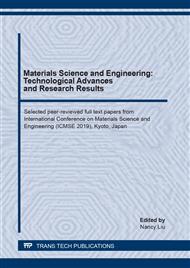[1]
ASTM F2792-12a, Standard Terminology for Additive Manufacturing Technologies, F42.19, Ed. West Conshohocken, PA: ASTM International, 2012. [Online]. Available: www.astm.org.
Google Scholar
[2]
C. Chua, S. Chou, and T. Wong, A study of the state-of-the-art rapid prototyping technologies,, The International Journal of Advanced Manufacturing Technology, vol. 14, no. 2, p.146–152, (1998).
DOI: 10.1007/bf01322222
Google Scholar
[3]
J. Dizon, A.H. Espera, Q. Chen, and R. Advincula: Mechanical characterization of 3D-printed polymers. Additive Manuf. 20, 44 (2018).
DOI: 10.1016/j.addma.2017.12.002
Google Scholar
[4]
AD Valino, JRC Dizon, AH Espera Jr, Q Chen, J Messman, RC Advincula, Advances in 3D Printing of Thermoplastic Polymer Composites and Nanocomposites, Progress in Polymer Science, 101162 S. Crump, Fast, Precise, Safe Prototype with FDM, ASME PED, vol. 50, 1991, p.53–60.
DOI: 10.1016/j.progpolymsci.2019.101162
Google Scholar
[5]
L.D. Tijing, J.R.C. Dizon, I. Ibrahim, H.Y. Shon, A.N. Nisay, R.C. Advincula, 3D printing for membrane separation, desalination and water treatment (accepted for publication Applied Materials Today).
DOI: 10.1016/j.apmt.2019.100486
Google Scholar
[6]
J.R.C. Dizon, Q. Chen, A.D. Valino, R.C. Advincula, Thermo-mechanical and swelling properties of three-dimensional-printed poly (ethylene glycol) diacrylate/silica nanocomposites. MRS Communications. 9, 209-217 (2019).
DOI: 10.1557/mrc.2018.188
Google Scholar
[7]
John Ryan C. Dizon, Arnaldo D. Valino, Lucio R. Souza, Alejandro H. Espera, Qiyi Chen, Rigoberto C. Advincula, Three-Dimensional-Printed Molds and Materials for Injection Molding and Rapid Tooling Applications, MRS Communications, Vol 9, 2019, pp.1267-1283. https://doi.org/10.1557/mrc.2019.147.
DOI: 10.1557/mrc.2019.147
Google Scholar
[8]
A.H. Espera, J.R.C. Dizon, Q. Chen, and R.C. Advincula, 3D-printing and advanced manufacturing for electronics. Progress in Additive Manufacturing. https://doi.org/1007/s40964-019-00077-7.
DOI: 10.1007/s40964-019-00077-7
Google Scholar
[9]
Al C. De Leon, Qiyi Chen, Napolabel B. Palaganas, Jerome O. Palaganas, Jill Z. Manapat, Rigoberto C. Advincula, Highperformance polymer nanocomposites for additive manufacturing applications, React. Funct. Polym. 103 (2016) 141–155.
DOI: 10.1016/j.reactfunctpolym.2016.04.010
Google Scholar
[10]
ASTM D785-03, Standard Test Method for Rockwell Hardness of Plastics and Electrical Insulating Materials, ASTM International, West Conshohocken, PA, 2003, www.astm.org.
Google Scholar
[11]
3D Printers will Build a Better Future for Developing Countries, Zortrax, [Online], 2017, Available: https://zortrax.com/blog/3d-printers-will-build-better-future-developing-countries/ [Accessed Sept 02, 2019].
Google Scholar
[12]
A. Bellini, S. Güçeri, Mechanical characterization of parts fabricated using fused deposition modeling, Rapid Prototyping Journal 9 (2003) 252–264.
DOI: 10.1108/13552540310489631
Google Scholar
[13]
J.F. Rodríguez, J.P. Thomas, J.E. Renaud, Mechanical behavior of acrylonitrile butadiene styrene (ABS) fused deposition materials. Experimental investigation, Rapid Prototyping Journal 7 (2001) 148–158.
DOI: 10.1108/13552540110395547
Google Scholar
[14]
V.D. Sagias, K.I. Giannakopoulus, C. Stergio, Mechanical Properties of 3D printed polymer specimens,, (2018).
Google Scholar
[15]
The Ultimate Guide to Stereolithography (SLA) 3D Printing, Formlabs, [Online], 2017, Available: https://archive-media.formlabs.com/upload/SLA_Guide.pdf [Accessed Sept 02, 2019].
Google Scholar
[16]
Ibrahim, Ahmed M. S. MD, PhD; Jose, Rod R. MEng; Rabie, Amr N. MD; Gerstle, Theodore L. MD; Lee, Bernard T. MD, MBA; Lin, Samuel J. MD, Three-dimensional Printing in Developing Countries, (2015).
DOI: 10.1148/cases.20202229
Google Scholar
[17]
Taguchi, G., Chowdhury, S., Wu, Y., 2005. Taguchi's Quality Engineering Handbook. John Wiley & Sons, Inc., New Jersey.
Google Scholar
[18]
Teruo, M., 2011. Taguchi Methods. ASME, New York.
Google Scholar
[19]
E. Alfredo Campo, 2008. Physical Properties of Polymeric Materials, Selection of Polymeric Materials How to Select Design Properties from Different Standards, 175-203.
DOI: 10.1016/b978-081551551-7.50007-3
Google Scholar
[20]
G. Sundararajan a, M. Roy b, 2001. Hardness Testing. Encyclopedia of Materials: Science and Technology (Second Edition) 2001, Pages 3728-3736.
DOI: 10.1016/b0-08-043152-6/00665-3
Google Scholar
[21]
Rockwell Type Hardness Tester HSR-1AN Instruction and Maintenance Manual, Shimadzu, (2018).
Google Scholar
[22]
Materials and Hardness Testing - The Importance of its Applications, AZO Materials, [Online] 2018, Available: https://www.azom.com/article.aspx?ArticleID=15122 [Accessed Sept 02, 2019].
Google Scholar
[23]
How to choose the right 3d printing material: understanding material properties of plastics, trideusblog, [Online] 2017, Available: https://trideusblog.wordpress.com/2017/01/26/how-to-choose-the-right-3d-printing-material-understanding-material-properties-of-plastics/ [Accessed Sept 02, 2019].
DOI: 10.1016/j.repl.2016.08.001
Google Scholar
[24]
What is the signal-to-noise ratio in a Taguchi design, Minitab 19 Support, [Online] 2019, Available:https://support.minitab.com/en-us/minitab/19/help-and-how-to/modeling-statistics/doe/supporting-topics/taguchi-designs/what-is-the-signal-to-noise-ratio/#targetText =In%20Taguchi%20designs%2C%20a%20measure,uncontrollable%20factors%20(noise%20factors) [Accessed Sept 02, 2019].
Google Scholar
[25]
Form Cure time and temperature settings, formlabs support, [Online] 2019, Available:https://support.formlabs.com/s/article/Form-Cure-Time-and-Temperature-Settings?language=en_US#targetText=The%20Form%20Cure%20uses%20heat,curing%20solution%20for%20Formlabs%20materials [Accessed Sept 02, 2019].
Google Scholar


